-
Determine the Q point of the transistor circuit shown in Fig. 4.40. Also draw the d.c. load line. Given ß = 200 and VBE =...
(Solved)
Determine the Q point of the transistor circuit shown in Fig. 4.40. Also draw the d.c. load line. Given β = 200 and VBE = 0.7V.
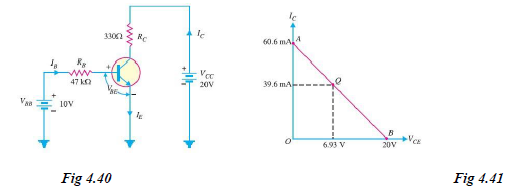
Date posted:
August 15, 2019
.
Answers (1)
-
In the circuit diagram shown in Fig. 4.39 (i), if VCC = 12V and RC = 6 kilo-ohms, draw the d.c. load line.
(Solved)
In the circuit diagram shown in Fig. 4.39 (i), if VCC = 12V and RC = 6 kilo-ohms, draw the d.c. load line. What will be the Q point if zero signal base current is 20μA and β = 50?
Date posted:
August 15, 2019
.
Answers (1)
-
For the circuit shown in Fig. 4.38 (i), draw the d.c. load line.
(Solved)
For the circuit shown in Fig. 4.38 (i), draw the d.c. load line.
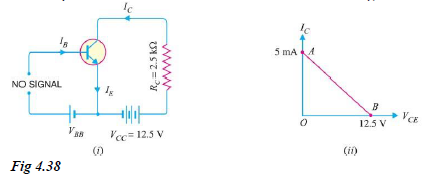
Date posted:
August 15, 2019
.
Answers (1)
-
Explain Transistor Load Line Analysis
(Solved)
Explain Transistor Load Line Analysis
Date posted:
August 15, 2019
.
Answers (1)
-
Explain Transistor as an Amplifier in CE Arrangement
(Solved)
Explain Transistor as an Amplifier in CE Arrangement
Date posted:
August 15, 2019
.
Answers (1)
-
Which are the Commonly Used Transistor Connection?
(Solved)
Which are the Commonly Used Transistor Connection?
Date posted:
August 15, 2019
.
Answers (1)
-
Show the Comparison of Transistor Connections
(Solved)
Show the Comparison of Transistor Connections
Date posted:
August 15, 2019
.
Answers (1)
-
Fig. 4.28 shows the short circuit failures in a transistor. What will be the circuit behaviour in each case ?
(Solved)
Fig. 4.28 shows the short circuit failures in a transistor. What will be the circuit behaviour in each case ?
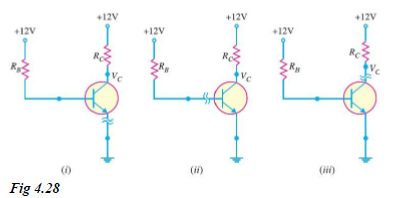
Date posted:
August 14, 2019
.
Answers (1)
-
Fig. 4.27 shows the open circuit failures in a transistor. What will be the circuit behaviour in each case ?
(Solved)
Fig. 4.27 shows the open circuit failures in a transistor. What will be the circuit behaviour in each case ?
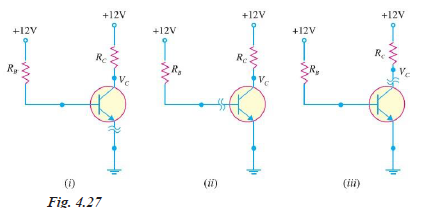
Date posted:
August 14, 2019
.
Answers (1)
-
A transistor has the following ratings: IC (max) = 500 mA and ßmax = 300.
(Solved)
A transistor has the following ratings: IC (max) = 500 mA and ßmax = 300. Determine the maximum allowable value of IB for the device.
Date posted:
August 14, 2019
.
Answers (1)
-
In a transistor, IB = 68 µA, IE = 30 mA and ß = 440.
(Solved)
In a transistor, IB = 68 µA, IE = 30 mA and ß = 440. Determine the a rating of the
transistor. Then determine the value of IC using both the a rating and ß rating of the transistor.
Date posted:
August 14, 2019
.
Answers (1)
-
A transistor is connected in common emitter (CE) configuration in which collector supply is 8V and the voltage drop across resistance RC connected in the...
(Solved)
A transistor is connected in common emitter (CE) configuration in which collector supply is 8V and the voltage drop across resistance RC connected in the collector circuit is 0.5V. The value of RC = 800 ohms. If α = 0.96, determine:
(i) collector-emitter voltage
(ii) base current
Date posted:
August 14, 2019
.
Answers (1)
-
For a transistor, ß = 45 and voltage drop across 1 kilo-ohm which is connected in the collector circuit is 1 volt.
(Solved)
For a transistor, β = 45 and voltage drop across 1 kilo-ohm which is connected in the collector circuit is 1 volt. Find the base current for common emitter connection.
Date posted:
August 14, 2019
.
Answers (1)
-
Find the a rating of the transistor shown in Fig. 4.20. Hence determine the value of IC using both a and ß rating of the...
(Solved)
Find the α rating of the transistor shown in Fig. 4.20. Hence determine the value of IC using both α and β rating of the transistor.
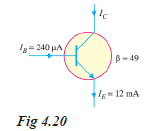
Date posted:
August 14, 2019
.
Answers (1)
-
Calculate IE in a transistor for which ß = 50 and IB = 20 µA.
(Solved)
Calculate IE in a transistor for which β = 50 and IB = 20 μA.
Date posted:
August 14, 2019
.
Answers (1)
-
Find the value of ß if;
(i) a = 0.9
(ii) a = 0.98
(iii) a = 0.99.
(Solved)
Find the value of β if;
(i) α = 0.9
(ii) α = 0.98
(iii) α = 0.99.
Date posted:
August 14, 2019
.
Answers (1)
-
Explain the Common Emitter Connection in transistors
(Solved)
Explain the Common Emitter Connection in transistors
Date posted:
August 14, 2019
.
Answers (1)
-
List the Transistor Connections or configurations
(Solved)
List the Transistor Connections or configurations
Date posted:
August 14, 2019
.
Answers (1)
-
A common base transistor amplifier has an input resistance of 20 ohms and output resistance of 100 kilo-ohms.
(Solved)
A common base transistor amplifier has an input resistance of 20 ohms and output resistance of 100 kilo-ohms. The collector load is 1 kilo-ohm. If a signal of 500 mV is applied between emitter and base, find the voltage amplification. Assume aac to be nearly one
Date posted:
August 14, 2019
.
Answers (1)
-
Explain how Transistor Circuit is used as an Amplifier
(Solved)
Explain how Transistor Circuit is used as an Amplifier
Date posted:
August 14, 2019
.
Answers (1)